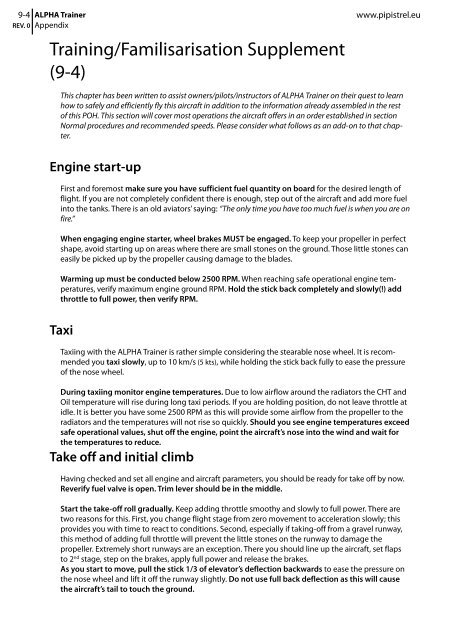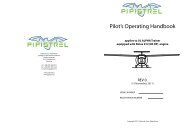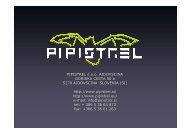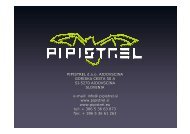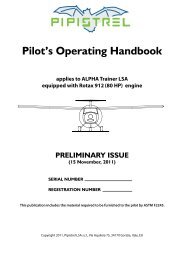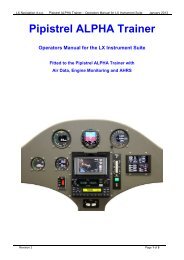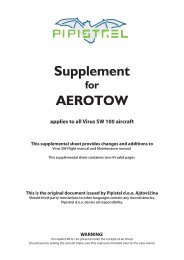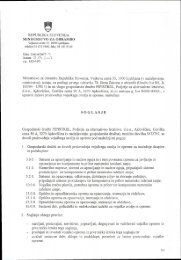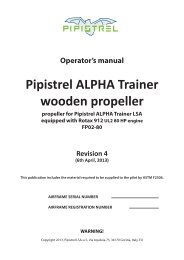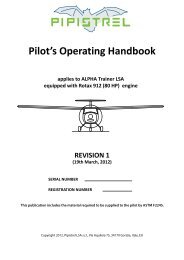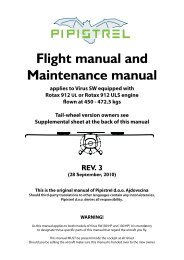Create successful ePaper yourself
Turn your PDF publications into a flip-book with our unique Google optimized e-Paper software.
9-4 <strong>ALPHA</strong> <strong>Trainer</strong><br />
REV. 0 Appendix<br />
Training/Familisarisation Supplement<br />
(9-4)<br />
www.pipistrel.eu<br />
This chapter has been written to assist owners/pilots/instructors of <strong>ALPHA</strong> <strong>Trainer</strong> on their quest to learn<br />
how to safely and efficiently fly this aircraft in addition to the information already assembled in the rest<br />
of this <strong>POH</strong>. This section will cover most operations the aircraft offers in an order established in section<br />
Normal procedures and recommended speeds. Please consider what follows as an add-on to that chapter.<br />
Engine start-up<br />
First and foremost make sure you have sufficient fuel quantity on board for the desired length of<br />
flight. If you are not completely confident there is enough, step out of the aircraft and add more fuel<br />
into the tanks. There is an old aviators’ saying: “The only time you have too much fuel is when you are on<br />
fire.”<br />
When engaging engine starter, wheel brakes MUST be engaged. To keep your propeller in perfect<br />
shape, avoid starting up on areas where there are small stones on the ground. Those little stones can<br />
easily be picked up by the propeller causing damage to the blades.<br />
Warming up must be conducted below 2500 RPM. When reaching safe operational engine temperatures,<br />
verify maximum engine ground RPM. Hold the stick back completely and slowly(!) add<br />
throttle to full power, then verify RPM.<br />
Taxi<br />
Taxiing with the <strong>ALPHA</strong> <strong>Trainer</strong> is rather simple considering the stearable nose wheel. It is recommended<br />
you taxi slowly, up to 10 km/s (5 kts), while holding the stick back fully to ease the pressure<br />
of the nose wheel.<br />
During taxiing monitor engine temperatures. Due to low airflow around the radiators the CHT and<br />
Oil temperature will rise during long taxi periods. If you are holding position, do not leave throttle at<br />
idle. It is better you have some 2500 RPM as this will provide some airflow from the propeller to the<br />
radiators and the temperatures will not rise so quickly. Should you see engine temperatures exceed<br />
safe operational values, shut off the engine, point the aircraft’s nose into the wind and wait for<br />
the temperatures to reduce.<br />
Take off and initial climb<br />
Having checked and set all engine and aircraft parameters, you should be ready for take off by now.<br />
Reverify fuel valve is open. Trim lever should be in the middle.<br />
Start the take-off roll gradually. Keep adding throttle smoothy and slowly to full power. There are<br />
two reasons for this. First, you change flight stage from zero movement to acceleration slowly; this<br />
provides you with time to react to conditions. Second, especially if taking-off from a gravel runway,<br />
this method of adding full throttle will prevent the little stones on the runway to damage the<br />
propeller. Extremely short runways are an exception. There you should line up the aircraft, set flaps<br />
to 2 nd stage, step on the brakes, apply full power and release the brakes.<br />
As you start to move, pull the stick 1/3 of elevator’s deflection backwards to ease the pressure on<br />
the nose wheel and lift it off the runway slightly. Do not use full back deflection as this will cause<br />
the aircraft’s tail to touch the ground.


